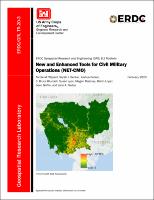Please use this identifier to cite or link to this item:
https://hdl.handle.net/11681/35621Full metadata record
| DC Field | Value | Language |
|---|---|---|
| dc.contributor.author | Wayant, Nicole M. | - |
| dc.contributor.author | Becker, Sarah J. | - |
| dc.contributor.author | Parker, Joshua M. | - |
| dc.contributor.author | Blundell, S. Bruce | - |
| dc.contributor.author | Lyon, Susan L. | - |
| dc.contributor.author | Maloney, Megan C. | - |
| dc.contributor.author | Lopez, Robin E. | - |
| dc.contributor.author | Griffin, Sean P. | - |
| dc.contributor.author | Nedza, John A. | - |
| dc.date.accessioned | 2020-02-20T18:52:58Z | - |
| dc.date.available | 2020-02-20T18:52:58Z | - |
| dc.date.issued | 2020-02 | - |
| dc.identifier.govdoc | ERDC/GRL TR-20-3 | - |
| dc.identifier.uri | https://hdl.handle.net/11681/35621 | - |
| dc.identifier.uri | http://dx.doi.org/10.21079/11681/35621 | - |
| dc.description | Technical Report | - |
| dc.description.abstract | Civil Military Operations (CMO) associated geospatial modeling is intended to enable increased knowledge of regional stability, assist in Foreign Humanitarian Assistance (FHA), and provide support to Force Health Protection (FHP) operational planning tasks. However, current geoenabled methodologies and technologies are lacking in their overall capacity to support complex mission analysis efforts focused on understanding these important stability factors and mitigating threats to Army soldiers and civilian populations. CMO analysts, planners, and decision-makers do not have a robust capability to both spatially and quantitatively identify Regions of Interest (ROI), which may experience a proliferation in health risks such as vector-borne diseases in areas of future conflict. Additionally, due to this general absence of geoenabled health assessment models and derived end-products, CMO stakeholders are adversely impacted in their Military Decision Making Process (MDMP) capabilities to develop comprehensive area studies and plans such as Course of Action (COA). The NET-CMO project is focused on fostering emerging geoenabling capabilities and technologies to improve military situational awareness for assessment and planning of potential health threat-risk vulnerabilities. | en_US |
| dc.description.sponsorship | ERDC 6.2 Geospatial Research and Engineering Program (U.S.) | en_US |
| dc.description.tableofcontents | Abstract .................................................................................................................................... ii Figures and Tables ................................................................................................................... v Preface .................................................................................................................................... vii 1 Introduction ...................................................................................................................... 1 1.1 Background ........................................................................................................ 1 1.2 Army challenge problems .................................................................................. 1 1.2.1 Problem 1 - Uniform pixel size for spatial disparate datasets .................................. 1 1.2.2 Problem 2 - Resolution of data in denied regions ..................................................... 1 1.2.3 Problem 3 - Mosquito-borne disease prediction ....................................................... 2 1.3 Approach ............................................................................................................ 2 1.4 Objective............................................................................................................. 3 2 Uniform Pixel Size ............................................................................................................ 4 2.1 Literature review ................................................................................................ 4 2.2 Geoanalytic data and methods ......................................................................... 6 2.2.1 Semivariograms .......................................................................................................... 6 2.2.2 Local spatial dispersion .............................................................................................. 9 2.3 Results and discussion ...................................................................................15 2.3.1 Semivariograms ........................................................................................................ 15 2.3.2 Local spatial dispersion ............................................................................................ 19 2.4 Cambodia population density dataset .......................................................... 23 3 Spatial Downscaling ...................................................................................................... 29 3.1 Literature review ............................................................................................. 29 3.2 Geoanalytic data and methods ...................................................................... 29 3.2.1 Data ........................................................................................................................... 30 3.2.2 Methods ..................................................................................................................... 30 3.3 Results and discussion .................................................................................. 33 3.4 Discussion ....................................................................................................... 34 4 Temporal Disaggregation .............................................................................................. 37 4.1 Literature review .............................................................................................. 37 4.2 Geoanalytic data and methods ...................................................................... 39 4.2.1 Data ........................................................................................................................... 39 4.2.2 Methods ..................................................................................................................... 41 4.3 Results and discussion .................................................................................. 42 4.3.1 Results ....................................................................................................................... 42 4.3.2 Discussion ................................................................................................................. 45 5 Mosquito-Borne Disease Simulation ........................................................................... 46 5.1 Literature review ............................................................................................. 46 5.2 Geoanalytic data and methods ................................ ................................ ....... 47 5.2.1 Data ........................................................................................................................... 48 5.2.2 Methods ..................................................................................................................... 49 5.2.3 Human and vector master equations ...................................................................... 51 5.3 Results and discussion ................................ ................................ .................. 52 5.3.1 Results ....................................................................................................................... 52 5.3.2 Discussion ................................................................................................................. 55 6 Project Summary ................................ ................................ ................................ ............ 56 6.1 Army mission support outcomes ................................ ................................ ... 56 6.2 Conceptual workflow ................................ ................................ ....................... 57 6.3 Stakeholder engagements ................................ ................................ ............. 58 6.3.1 U.S. Army Walter Reed Biosystematics Unit .............................................. 58 6.3.2 Army Public Health Command : Tick-Borne Diseases Lab .............. 59 6.3.3 Army Force Health Protection and Preventive Medicine: MEDDAC-Korea/65th Medical Brigade .................................................................................................... 59 6.4 Potential for transition ................................ ................................ .................... 60 6.4.1 Map based planning system ....................................................................... 60 6.4.2 Harris ENVI ................................................................................................................ 61 6.5 Next generation of NET NET-CMO ................................ ................................ ......... 62 6.5.1 Systemic integration ................................................................................................. 62 6.5.2 Product space ........................................................................................................... 62 6.6 Concluding remarks ................................ ................................ ....................... 63 References ................................ ................................ ................................ ............................. 65 Appendix A: NET NET-CMO Summary ................................ ................................ ......................... 71 Appendix B: Species Distribution Modeling of Ixodes scapularis and Ass ociate Pathogens in States East of the Mississippi River Summary ................................ ... 72 Appendix C: Understanding the Disease Vector Operational Environment by Predicting Presence of Anopheles Mosquito Breeding Sites Using Maximum Entropy Modeling Summary ................................ ................................ ....... 74 Acronyms ................................ ................................ ................................ ............................... 76 Report Documentation Page | - |
| dc.format.extent | 86 pages / 3.658 Mb | - |
| dc.format.medium | PDF/A | - |
| dc.language.iso | en_US | en_US |
| dc.publisher | Geospatial Research Laboratory (U.S.) | en_US |
| dc.publisher | Engineer Research and Development Center (U.S.) | - |
| dc.relation.ispartofseries | Technical Report (Engineer Research and Development Center (U.S.)) ; no. ERDC/GRL TR-20-3 | - |
| dc.rights | Approved for Public Release; Distribution is Unlimited | - |
| dc.source | This Digital Resource was created in Microsoft Word and Adobe Acrobat | - |
| dc.subject | United States--Armed Forces--Stability operations | en_US |
| dc.subject | Humanitarian assistance | en_US |
| dc.subject | Geospatial data | en_US |
| dc.subject | Geographic information systems | en_US |
| dc.subject | Mosquitoes as carriers of disease | en_US |
| dc.title | New and Enhanced Tools for Civil Military Operations (NET-CMO) | en_US |
| dc.type | Report | en_US |
| Appears in Collections: | Technical Report | |
Files in This Item:
| File | Description | Size | Format | |
|---|---|---|---|---|
| ERDC-GRL TR-20-3.pdf | 3.75 MB | Adobe PDF |  View/Open |